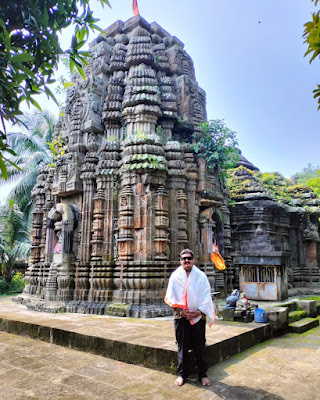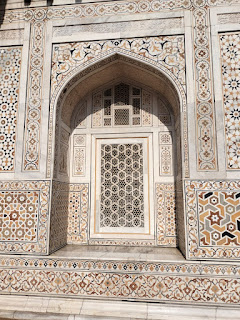(Puri District, Odisha, October 2023)
 |
| Me at Gangeswari Temple, Bayalish Bati, Erabanga - Gop |
It was the first time that I got into a State Government operated MO bus from Puri to Bhubaneshwar, and after getting down at Gop Bus stop, I reached the scenic and unassuming village of Bayalish Bati, literally meaning the village of forty houses. Away from the hustle and bustle of the Golden Triangle of Odisha tourism, the little village possesses the temple of Maa Gangeshwari Devi, the kul devi of the Eastern Gangas of Kalinga.
 |
| Lord Surya, the Sun God on his seven horse chariot - on the backside of Barahi Deula, Chaurasi |
The temple seems forgotten, with thick shrubs and creepers making their mark on the Deula. The Eastern Gangas, at their zenith (c.11th-14th Centuries), with stalwart kings like Aanantavarman Chodagangadeva, Langula Narasingha Deba, were responsible for the proliferation and perfection of Kalinga style of Rekhi architecture, with Puri and Konark remaining the greatest examples. A legend refers to Bayalish Bati as a village of architects and sculptors including Sebei Mahapatra, of Konark Sun Temple fame. The temple at this village could have been a prototype of the more famous Sun Temple of Konark. The sculptures and images, including Saptamatrikas, Mithun, and especially Varahi Devi are amazing.
 |
| Barahi Deula, Chaurasi, Lateral View |
The Varahi Temple / Barahi Deula located in Chaurasi village of Prachi river valley, located on Nimpada - Katakpur road is another interesting temple. Attributed to Somavamsa Gajapatis of Early 9th Century CE, the main idol in the sanctum santorum is dedicated to Goddess Matsya Varahi, representing Tantricism and Saktism, and is unique. Seated in lalitasana, the divine woman with a boar head and a Kapala and Fish in each hand, invokes awe. The temple itself is planned on Khakhara model, with Sandstone material and images like Lord Surya, the Sun God driving his seven horsed chariot are arresting. Bhog (Mahaprasada) of Jagannatha Temple is taken to this temple everyday.
 |
| Inside the Chausath Yogini Temple, Hirapur |
The Chausath Yogini Temple / Mahamaya Temple, is located 20 Kms away from the capital of Bhubaneshwar, and is another unique, but lesser known masterpiece. Yoginis are mythical, auspicious practicioners of Tantra and Yoga, associated with Sanatana Dharma and Buddhism. This little, hypaethral, circular shaped shrine is dedicated to the 64 Yoginis (Hence the name Cahusath i.e, 64), with most of the images in a damaged state. Sadly, there is no proper maintenance. Eastern India, since ancient times was a stronghold of Shaktism and Tantricism and this temple is a living proof. This is the oldest Yogini temple in India, dated c.864 CE, commissioned by Queen Hiradevi of Bhouma Dynasty. A famous local legend ascribes to Goddess Durga taking 64 forms to defeat demons and now consecrated as Mahamaya Devi, the main deity of this temple.
 |
| A Yogini inside the Chausath Yogini Temple, Hirapur |
It was a fruitful day for me, as I got to offer obeisance to the Goddesses of these iconic temples, and to witness the unsung glory of Kalinga.
.jpeg) |
| Me Outside the Chausath Yogini Temple, Hirapur |
Around Sri Kshetra, In awe of the Goddesses of Puri..
Maheeth
Veluvali,
16 Saladi Jamindar Street, Palakollu,.
11th of June, 2025.


.jpeg)
.jpeg)










.jpeg)

.jpeg)
.jpeg)







